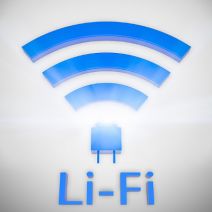Horne & Benik Networks Blog
Game Changer: New Li-Fi Technology Transmits Data via Light!
 WiFi and Wireless Internet connections are an integral part of any workplace infrastructure. They essentially allow workers to pick up their wireless technology, like smartphones, tablets, or laptops, and connect to a network from any location with a connection. This convenience was previously unprecedented, but now a new technology threatens to usurp WiFi’s coveted throne; Li-Fi, wireless Internet connections delivered via light.
WiFi and Wireless Internet connections are an integral part of any workplace infrastructure. They essentially allow workers to pick up their wireless technology, like smartphones, tablets, or laptops, and connect to a network from any location with a connection. This convenience was previously unprecedented, but now a new technology threatens to usurp WiFi’s coveted throne; Li-Fi, wireless Internet connections delivered via light.
The idea might sound far-fetched at first, and until very recently Li-Fi was considered nothing more than a theory. Now, however, it’s been tested in a real-world environment, and it’s proving to be an exceptional innovation. When tested, Li-Fi was capable of transferring data at speeds of around 1GB/second. As explained by ScienceAlert:
The technology uses Visible Light Communication (VLC), a medium that uses visible light between 400 and 800 terahertz (THz). It works basically like an incredibly advanced form of Morse code - just like switching a torch on and off according to a certain pattern can relay a secret message, flicking an LED on and off at extreme speeds can be used to write and transmit things in binary code.
According to Professor Harald Haas, the creator of Li-Fi, Li-Fi addresses four of the main issues that most organizations have with their current wireless communications:
- Capacity: WiFi currently uses electromagnetic waves (particularly radio waves) for communication, which are limited in scope and, most importantly, range. These limits don’t align with society’s need for wireless data transmission, and there’s only so much space on the spectrum remaining. Light, on the other hand, travels at a much greater frequency than your typical radio waves--approximately 10,000 times faster, making for exceptionally faster data transfer speeds.
- Efficiency: At the present moment, data transfer is currently being distributed by base stations, which aren’t necessarily energy efficient. Only about five percent of the energy is used to transfer data while the rest is used to cool the base station. For Li-Fi, in terms of financial efficiency, data transferred alongside light essentially eliminates the costs of data transmission. There’s already a huge amount of light bulbs in the world that can be exploited for this purpose; the infrastructure already exists, and these LED bulbs can be used for Li-Fi data transfer.
- Availability: WiFi has limited availability in certain locations, and can’t be used in others (think hospitals and airplanes). Considering how visible light is all around us, light being available isn’t a question of “if,” but “how” we can use that energy.
- Security: Arguably most important of all is security. As we all know, wireless signals delivered by radio waves can go through walls into the outside world, where hackers and other malicious entities might be waiting. Light, on the other hand, can’t pass through walls, which means that it’s more likely to stay secure than a wireless signal broadcast to the entire vicinity.
Ideally, as Haas puts it, the world can solve the problem of high-speed wireless data transfer by taking advantage of Li-Fi. While the technology is still in development, it has been tested outside the lab environment and is currently being put on trial in both manufacturing and office settings.
Would you want to take advantage of Li-Fi? Let us know in the comments.

Comments